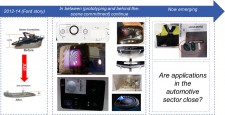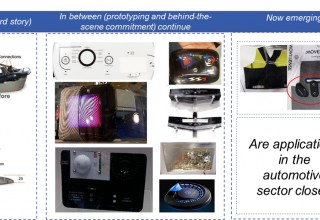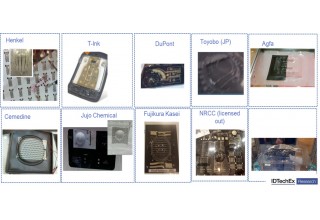IDTechEx Research Report Finds In-Mold Electronics Are Becoming Commercial Once Again

BOSTON, June 20, 2018 (Newswire.com) - Conductive inks are a wonderfully adaptive technology. This characteristic has enabled them to stay relevant and to rejuvenate themselves over the past several decades. This is because as old markets have struggled or declined the technology has managed to find and/or create new uses. Several years ago, a new frontier called in-mold electronics (or IME) started to emerge. This frontier, as reported in the IDTechEx Research report Conductive Ink Markets 2018-2028: Forecasts, Technologies, Players, is once again becoming commercial.
IME is not a product but is a process. Here, functional and graphical printing are carried out on a 2D flat substrate which is then formed and moulded into a 3D shaped. As such, it provides a way to structurally integrate the electronics into 3D shaped objects whilst using high throughput production processes suited to volume applications. This approach enables novel, elegant, and space-saving designs.
Products made with IME (and conductive inks) are once again on the market. This, IDTechEx Research believe, is just the first step. Indeed, soon, we expect to see bigger announcements in industries such as in the automotive.
Dr. Khasha Ghaffarzadeh, Research Director, IDTechEx
The schematic (Figure 1) shows the commercial progression of IMEs. It started being developed from 2007/8 onwards. The first successful product was launched in a Ford car in 2012. Here, using IME, the overhead console had been made thin and light. This, at the time, was considered a major commercial coup for printed electronics.
However, the product was soon recalled. IDTechEx understood that the overhead console gave false read-outs. The origin of the error, at the time, was attributed to the streamlining steps that were taken during the pilot to mass production transition. This failure put the industry back and caused users to be extra cautious.
The interest, however, did not die. As shown in Figure 1, many prototypes were developed. These include prototypes for use in consumer electronics, whitegoods/home appliances and automotive applications. IDTechEx Research visits to end user sites confirmed that there were active engagements behind the scene. In this time, the technology also become more known. Many material suppliers appeared, pushing the technology and seeding the market. The IME houses also became more active, helping users do prototypes and pilot studies.
Products made with IME (and conductive inks) are once again on the market. An example is shown in Figure 1. This is a wearable device with structurally integrated metallization. This, IDTechEx Research believe, is just the first step. Indeed, soon, we expect to see bigger announcements in industries such as in the automotive. The market, therefore, has overcome its past failure and turned a page. To learn more about this process visit www.IDTechEx.com/ink.
IME is made possible thanks to the adaptability of conductive ink technology. Here, the formulations and filler compositions must be adjusted to withstand a major one-off elongation event during the forming (during the transition from a flat sheet to a 3D shape); and to survive the thermoforming and moulding conditions.
The interest on the part of ink suppliers has dramatically increased over the past few years. This is in line with the interest in stretchable conductive inks. Indeed, as shown in Figure 2, today many paste makers have either already launched a product or have demonstrated the capability to serve the market.
The competition, therefore, is intensifying and as such IDTechEx Research expect that premium pricing will not hold over the long run. This is, however, not to say that there is no room for differentiation on service or performance. In terms of the service, the ability to work with customers closely and customize solutions – or tweak solutions – for specific use cases is highly valued. This is because established figures of merit do not yet exist to enable offering commodity-like standardized products. In terms of performance, not all the inks are the same. Some users tell IDTechEx Research that, for example, some pastes are superior in terms of handling sharp bends whilst some offer better adhesion.
Furthermore, as is the case with stretchable conductive inks, suppliers must now take a total solution approach. As such, they are now offering a full portfolio of IME compatible materials (and not just conducive inks). This is an asset because the supplier becomes a one-stop-shop, because it eases the development burden on the user, and because it allows the suppliers to aggressively price elements of the portfolio where competition is rife whilst making higher margins in other parts.
To learn more please refer to Conductive Ink Markets 2018-2028: Forecasts, Technologies, Players. This report provides the most comprehensive and authoritative view of the 2370 tpa conductive inks and paste market, giving detailed ten-year market forecasts segmented by application and material type. The market forecasts are given in tonnage and value at the ink level.
About IDTechEx
IDTechEx guides your strategic business decisions through its Research and Events services, helping you profit from emerging technologies. IDTechEx provides independent research, business intelligence and advice to companies across the value chain based on our core research activities and methodologies.
Learn more at www.IDTechEx.com.
Media Contact:
Charlotte Martin
Marketing & Research Coordinator
c.martin@IDTechEx.com
+44(0)1223 812300
Source: IDTechEx Research

